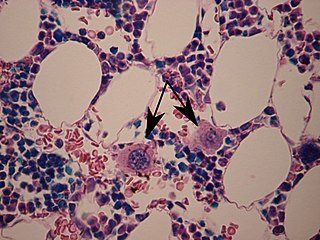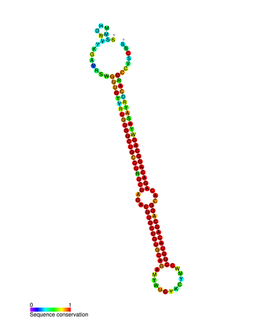| miR-150 | |
|---|---|
 Conserved secondary structure of miR-150 microRNA precursor | |
| Identifiers | |
| Symbol | miR-150 |
| Alt. Symbols | MIR150 |
| Rfam | RF00767 |
| miRBase | MI0000479 |
| miRBase family | MIPF0000197 |
| Entrez | 406942 |
| HUGO | 31537 |
| OMIM | 610566 |
| RefSeq | NR_029703 |
| Other data | |
| RNA type | miRNA |
| Domain(s) | Mammalia |
| GO | 0035195 |
| SO | 0001244 |
| Locus | Chr. 19 q13.33 |
| PDB structures | PDBe |
miR-150 is a family of microRNA precursors found in mammals, including humans. The ~22 nucleotide mature miRNA sequence is excised from the precursor hairpin by the enzyme Dicer. [1] This sequence then associates with RISC which effects RNA interference. [2]

A microRNA is a small non-coding RNA molecule found in plants, animals and some viruses, that functions in RNA silencing and post-transcriptional regulation of gene expression. miRNAs function via base-pairing with complementary sequences within mRNA molecules. As a result, these mRNA molecules are silenced, by one or more of the following processes: (1) Cleavage of the mRNA strand into two pieces, (2) Destabilization of the mRNA through shortening of its poly(A) tail, and (3) Less efficient translation of the mRNA into proteins by ribosomes.

Mammals are vertebrate animals constituting the class Mammalia, and characterized by the presence of mammary glands which in females produce milk for feeding (nursing) their young, a neocortex, fur or hair, and three middle ear bones. These characteristics distinguish them from reptiles and birds, from which they diverged in the late Triassic, 201–227 million years ago. There are around 5,450 species of mammals. The largest orders are the rodents, bats and Soricomorpha. The next three are the Primates, the Cetartiodactyla, and the Carnivora.

Humans are the only extant members of the subtribe Hominina. Together with chimpanzees, gorillas, and orangutans, they are part of the family Hominidae. A terrestrial animal, humans are characterized by their erect posture and bipedal locomotion; high manual dexterity and heavy tool use compared to other animals; open-ended and complex language use compared to other animal communications; larger, more complex brains than other animals; and highly advanced and organized societies.
Contents
miR-150 functions in hematopoiesis; it regulates genes whose downstream products encourage differentiating stem cells towards becoming megakaryocytes rather than erythrocytes. [3] [4] It is also thought to control B and T cell differentiation, alongside mir-155. [5] [6]

A megakaryocyte is a large bone marrow cell with a lobated nucleus responsible for the production of blood thrombocytes (platelets), which are necessary for normal blood clotting. Megakaryocytes usually account for 1 out of 10,000 bone marrow cells in normal people, but can increase in number nearly 10-fold during the course of certain diseases. Owing to variations in combining forms and spelling, synonyms include megalokaryocyte and megacaryocyte.

B cells, also known as B lymphocytes, are a type of white blood cell of the lymphocyte subtype. They function in the humoral immunity component of the adaptive immune system by secreting antibodies. Additionally, B cells present antigen and secrete cytokines. In mammals, B cells mature in the bone marrow, which is at the core of most bones. In birds, B cells mature in the bursa of Fabricius, a lymphoid organ..

A T cell is a type of lymphocyte which developes in the thymus gland and plays a central role in the immune response. T cells can be distinguished from other lymphocytes by the presence of a T-cell receptor on the cell surface. These immune cells originate as precursor cells, derived from bone marrow, and develop into several distinct types of T cells once they have migrated in to the thymus gland - for which these cells are named. T cell differentiation continues even after they have left the thymus.

















